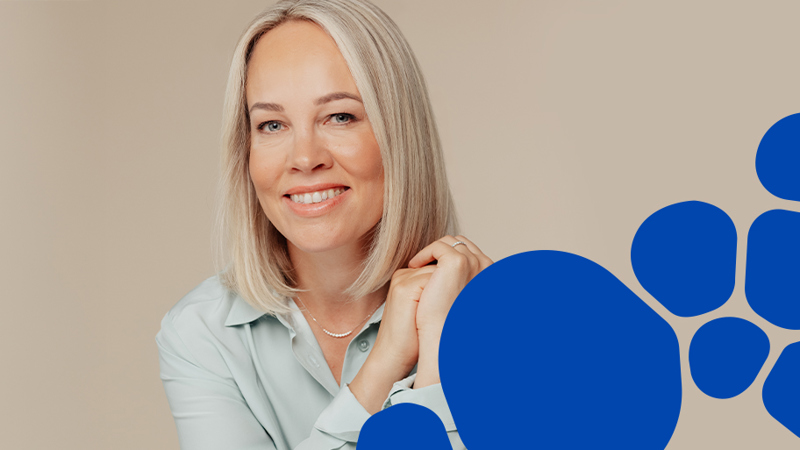Here are the digital trends in healthcare 2024
Artificial intelligence, health assistants, preventive care and personalised medicine - the digital trends in healthcare in 2024 will focus on how we can modernise healthcare and tackle its deepest problems.

We are in the midst of an uncertain economic situation and a mental health crisis. On top of this, Finland's population is ageing. It is estimated that we will need up to more than 100 000 new health professionals in the next 10 years . This is a practically impossible task. If we are unable to reform the health system, the shortage of care will get even worse.
Digital innovations offer promising opportunities to address the problems of healthcare. Advances in artificial intelligence are setting in motion many developments.
1. Integrated digital platforms - what Finland leads, Europe follow
Digital platforms refer to the whole digital ecosystem of healthcare: e.g. electronic health record systems, analytics, remote services and mobile applications that bring together information in an easily accessible way.
In Finland, we are about 10 years ahead of the rest of Europe in the use of digital platforms for healthcare, especially in the private sector. Our performance is closely monitored in other parts of the world. In Finland, the trend for the coming year is to combine different platforms - such as remote consultation tools and patient information systems - into one powerful tool for healthcare professionals.
Another important trend is the integration of digital platforms into the overall healthcare system, so that patient care moves seamlessly and smoothly between digital and bricks-and-mortar services. For example, Terveystalo has just introduced a digital symptom assessment for its occupational health clients. The customer fills in a symptom questionnaire, which is linked to a logic system that directs them directly to a remote or brick-and-mortar clinic, a general practitioner or, for example, a physiotherapist.
The symptom assesment tool eliminates the need for the customer to know the right professional or channel for their condition. The assessment also makes a significant difference to the practice: the patient does not arrive at the practice without any initial information, but the professional has the most important information beforehand. Time is saved in the practice for treatment and continuity of care is improved
2. AI enables more meaningful work for the healthcare professional and prevents diseases
From drug development to patient care, AI is predicted to revolutionise healthcare. AI will evolve at breakneck speed in 2024 and will play a major role in how we free up the time of healthcare professionals to focus on the most important thing: meeting patients.
For example, we know that currently up to more than 8 hours of doctors' total workload per month is spent on recording opinions. In the future, this task could be performed by an AI, which will act as a personal assistant to the doctor: a support brain. The assistant will be able to write the patient's report, prescriptions and referrals based on the admission interview - the doctor will continue to be responsible for treatment decisions. Such assistants already exist: for example, the work of radiologists is supported by an AI that informs them of possible findings in X-rays.
3. Telehealth 2.0 - We have electrified healthcare, now it's time to digitise it
In the wake of the Covid-19 pandemic, there was a major shift in healthcare to remote channels. But this was only a channel shift: the electrification of familiar care, not digitalisation.
In 2024, remote consultations will be developed in particular in terms of their potential to support follow-up care and the diseases for which digital-only care pathways can be developed. Such conditions could include, for example, urinary tract infections.
The expansion of telehealth may also be revolutionised by the development of the metaverse, the digital twin and the IoT, or Internet of Things. For example, data collected by various devices that measure health information, such as thermometers or heart rate monitors, can be automatically transmitted to the doctor during a remote visit.
As more diseases can be treated and monitored remotely, access to care will become more equitable. At Terveystalo, for example, remote consultations are already available in seconds on average, around the clock, every day of the year.
4. Care pathways are the first step towards a digital health assistant
Digital care pathways can ensure smooth and high-quality integrated care. At Terveystalo, digital care pathways have been in use for about a year and are now gaining ground worldwide.
A patient enters a care pathway when they are diagnosed with a condition or a proactive signal is identified. An automated care pathway, based on, for example, current national care recommendations, then takes care of the different stages of the patient's care, from treatment planning and implementation to follow-up. It also seamlessly integrates different healthcare services - be it medical care, psychological support, remote or outpatient care.
Thanks to the digital care pathway, patients do not have to remember what happens next or what appointments to book. Patients can follow the progress of their care pathway, for example via a mobile app. Care pathways can therefore be seen as a first step towards a digital health assistant that can be carried around in your back pocket. The assistant provides home care instructions, reminders, manages appointments and offers an ongoing health partnership.
5. Personalised healthcare prevents and treats diseases in a way that works for you
Currently, healthcare treats illnesses solely on the basis of the disease, not on the basis of the patient's individual needs. One of the trends for the coming year will be personalising healthcare with data.
A huge amount of data is constantly being collected about each of us, including in healthcare. With the help of artificial intelligence, we can analyse and make better use of this so-called "big data" and create, for example, a digital twin of the patient.
A digital twin can mean a digital version of a patient, with constantly evolving data. It will give professionals better tools to meet the patient and personalise care based on the data available.
In practice, this can translate into more personalised care pathways, for example. Even if the condition is the same, everyone's care pathway will look different based on previous diagnoses, medical records, other conditions, allergies, personal symptoms, experiences and even genetics.
The data analysed by AI can also be used for disease prevention. Preliminary research evidence is already available on how machine learning can be used to predict mental health diagnoses based on personalised patient questionnaires.
Read more blogs

Let's reform occupational health together
Laura Karotie, SVP Corporate Health at Terveystalo, shares her initial observations on how occupational health can be developed in a customer-oriented and sustainable manner.

Here are the digital trends in healthcare 2025: AI frees up time and supports quality of care
Ilari Richardt, Director of Digital Services at Terveystalo, highlights five major digital trends that will transform healthcare this year. At the heart of these trends is the potential of artificial intelligence to solve healthcare problems.

Good medicine requires the right tools
Medicine, like many other sciences, is advancing by leaps and bounds. The fact that medicine guides our work means that we deliver the most effective care as recommended. This requires us to constantly evolve and keep ahead of the scientific curve, so that we can act in the best interests of our customers, using all appropriate and possible means.

Occupational health psychologists are underutilized amidst the tsunami of mental health issues
The increase in psychological problems and burnout at work is constantly being discussed. Mental health disorders are one of the major causes of decreased work efficiency, absenteeism, and transition to disability pensions. One might ask why this situation persists, despite the fact that our country has a unique and highly regarded occupational health care system, with a large number of experts in the connection between work and mental health – us occupational health psychologists.

Where there is love for medicine, there is love for humanity
Hippocrates' wise words help us make the right choices. Our commitment to our mission, working for a healthier life, extends beyond the provision of quality health services to the promotion of human rights throughout our value chain.

Together towards a healthier workplace: The power of occupational health partnership
A healthy workplace is the result of collective effort, and Finnish business decision-makers share this view. Customer Relationship Director Terhi Nieminen explains how Terveystalo focuses on proactive measures and multidisciplinary collaboration, supporting the well-being of workplaces and employees comprehensively. This way, we create value that promotes sustainable success and addresses the challenges of the future working life.